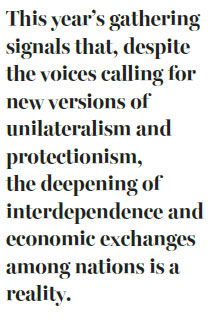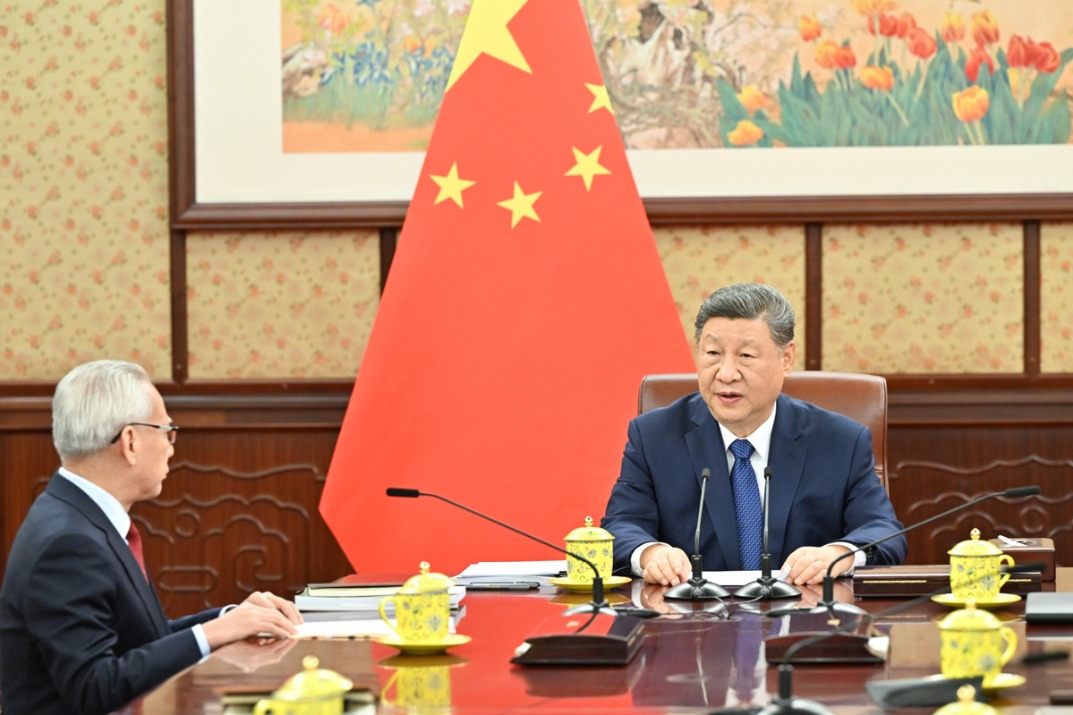New alliance has tilted the balance of power

After humble origins, organization has developed into a valuable forum for non-Western nations
It is, along with the Shanghai Cooperation Organization, another highly significant illustration of the global redistribution of power.
Within less than a decade, the BRICS Summit, where Latin America (Brazil), the vast Eurasian continent (Russia, India, China) and Africa (South Africa) connect, has become a key player in international politics. From a mere BRIC - Brazil, Russia, India, China - acronym coined by the British economist Jim O'Neill in 2001, it evolved into an impactful forum whose importance is proportionate with the growing economic and political weight of its members.
While the G20 is the mark of a multipolar world beyond exclusive Western dominance over global affairs, the BRICS dynamics point toward a century defined by the growing significance of South-South relations. When trade increasingly links the BRICS countries, whose combined GDP is more than 20 percent of the world economy, Western Europe and North America do not stand at the center anymore.

This year's gathering signals that, despite the voices calling for new versions of unilateralism and protectionism, the deepening of interdependence and economic exchanges among nations is a reality. The West might fear globalization, the United States can be tempted by protectionism, but this can't trigger a de-globalization. The globalizing forces have simply shifted from one source to another. It is around non-Western regions that new forms of multi-lateralism and cooperation are taking shape. For Brazil, Russia, India and South Africa, China has become the number one trading partner around which they have to design their economic policies and adjust their diplomatic positions.
An important achievement of the BRICS synergies has been the creation of the New Development Bank, headquartered in Shanghai's financial district. Its recently opened Africa Regional Center in Johannesburg constitutes, for the African continent, an opportunity to deepen its links with Latin America and the three Eurasian giants.
An international financial mechanism created by non-Western countries, the NDB is a step toward the institutionalization of the BRICS process and a laboratory at the service of a more inclusive and sustainable development.
The BRICS dynamics are engineered by the developing countries for their own benefit, but they also contribute to global stability. As mentioned in the Goa Declaration following the 8th BRICS Summit, the first set of loans by the NDB to support projects involving renewable energy put sustainability and the commitment to fight climate change at the top of the BRICS agenda.
Meanwhile, a Contingent Reserve Arrangement has been established, aimed at providing a financial safety net for countries exposed to market fluctuations. One of the immediate motivations to organize the first BRIC Summit - which evolved into BRICS when South Africa joined at the third Summit in 2011 - in the year following the 2008 financial crisis was to discuss mechanisms that would guard against severe financial disruptions.

Having functions similar to those of the World Bank, as a provider of loans, but also of the International Monetary Fund - to secure financial stability - the New Development Bank enriches the global financial landscape. It does not contradict the system born at the Bretton Woods Conference at the end of the World War II but complements it and is reflection of a new distribution of power
Beyond finance and economics, and in a general context marked by uncertainties, the Xiamen gathering sends an important geopolitical message. While the media choose to continuously report on the spectacular Sino-Indian tensions over Donglang, the interactions between Chinese President Xi Jinping and Indian Prime Minister Narendra Modi demonstrate their ability to take into consideration the big picture and to look at negotiations and dialogue as the way to manage the current disagreements between the two giants.
Neither Xi nor Modi will sacrifice the overall Sino-Indian synergies for a confrontation over Donglang, and the converging forces of the BRICS dynamics, playing the role of a security architecture, will keep them even further away from an escalation over the border issue.
China and India, two major civilizations, the world's most populated countries with 35 percent of the world population, share a border of 2,659 kilometers - approximately equivalent to the total land boundary of France - in a region where historical inheritance is almost as complex as the Himalayan topography.
However, for centuries these two great civilizations have coexisted in peace, often cross-fertilizing. They have enough wisdom in their respective traditions to remain focused on co-development and peaceful synergies, a path that could lead them, in a not too distant future, to stand as the two strongest pillars of a more harmonious global system.
The author is founder of the Europe-China Forum (since 2002) and of the New Silk Road Initiative. The views do not necessarily reflect those of China Daily.
(China Daily Africa Weekly 09/01/2017 page9)
Today's Top News
- China accelerates push for autonomous driving
- Opening of new gateway can help foster global economic and trade cooperation
- The farmer, the snake and Japan's memory hole
- Crossing a milestone in the journey called Sinology
- China-Russia media forum held in Beijing
- Where mobility will drive China and the West






























